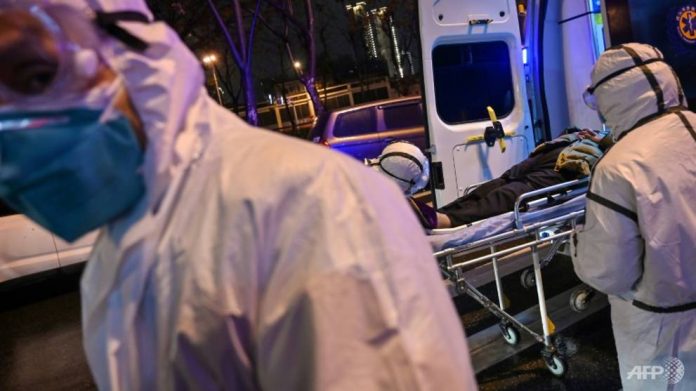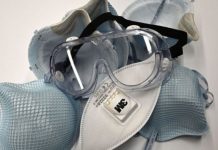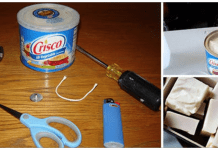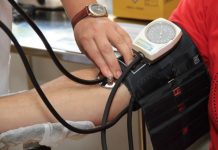A patient in California’s Orange County was on Saturday (Jan 25) confirmed as the third person on US soil infected with the new deadly virus that originated in China, health officials said.
The infected person was a traveller from Wuhan, the Chinese city at the epicenter of the outbreak, the Orange County Health Care Agency said.
The Centers for Disease Control and Prevention (CDC) confirmed the patient had tested positive for the novel coronavirus, it said.
The individual was in isolation in a local hospital and was in good condition.
“There is no evidence that person-to-person transmission has occurred in Orange County. The current risk of local transmission remains low,” the health care agency said.
There were no details given on how the person arrived in the United States or their identity.
The two other US cases involve a woman in Chicago who had traveled to Wuhan in late December before returning to the US on Jan 13, and a man in his thirties from Washington state who had also traveled to the Chinese city recently, the CDC said.
The disease has also shown up in other parts of China, as well as Japan, South Korea, Taiwan, Thailand, France, Ireland and Australia. So far there are 2000 confirmed cases, and 56 people have died in China from the disease.
Official concern for the outbreak has caused Chinese officials to quarantine Wuhan, Huanggang and Ezhou, and another dozen cities that are home to more than 50 million people in a possibly belated effort to stop the spread of the disease.
Since the vast majority of the cases are still within Wuhan, closing it off could end the spread of the Coronavirus, if victims of the disease who are outside the city can be isolated and kept under medical observation until it is clear that their bodies’ immune systems have overcome the virus and killed it.
American officials, especially from the CDC are taking this pandemic seriously as well. The CDC has dispatched 100 workers to set up screening stations in five airports, to verify that anyone entering the United States from the vicinity of Whuan, China.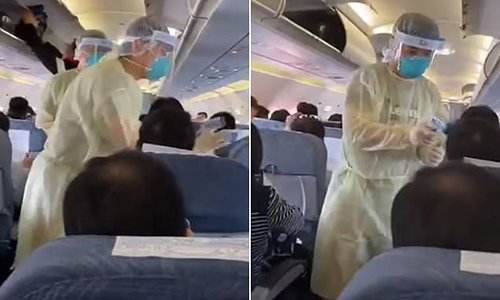

These screening stations are being established in New York’s JFK airport, San Francisco, Los Angeles, Harsfield-Jackson Atlanta International Airport and Chicago’s O’Hare International airport. Anyone returning to the US, whose flight arrangements do not include passing through one of those five airports upon arrival in the US will have their flights rerouted so that they can be screened.
Related: 30 Supplies for Pandemic Survival
What are We Dealing With?
The Coronavirus is not a single virus strain; but rather a family of seven related strains, like influenza. Just as with the flu, various strains affect people differently, ranging in seriousness from symptoms akin to the common cold, up to serious diseases like SARS (Severe Acute Respiratory Syndrome) or MERS (Middle East Respitatory Syndrome).
Little is known about the victims who have already died from the disease, although they are all within the borders of China. No fatalities have been reported from any of the other four countries which have been affected. While we don’t know this for sure, it is probably that those who died had some underlying respiratory problem, which the Coronavirus attacked. This happens in the case of many victims who die of the flu.
At first it was believed that the virus only spread from animals to humans, but it has now been confirmed that it spreads from human to human as well. Unfortunately, the exact mechanism of spreading is not yet understood. It will take time for the CDC to run the necessary experiments to quantify the risk and means of spreading.
The Spread of Viruses
Typically, viruses spread through bodily contact or bodily fluids. The most dangerous is when they are airborne, spread through what is known as “aerosol.” This is nothing more than the droplets of mucus and saliva that are released through coughing and sneezing. Those droplets can travel as far as six feet, but the viruses they contain can travel even farther. All it takes it breathing in those virus particles and you can become infected.
But that’s not the only way that viruses can spread. If someone has a virus-caused disease and they cough or sneeze, the virus can be deposited on their hand, when they move to cover their mouth and nose (as we’ve all been taught to do). Then, if they shake hands with someone else, that virus can be spread to their hands.
Viruses on the outside of our body aren’t dangerous. The skin, as part of our immune system, does an excellent job of blocking out microscopic pathogens. To get into the body, viruses, bacteria and protozoa need to find openings in the skin; either those which occur naturally or cuts and contusions.
Most of our natural body openings are in the head; specifically, the eyes, ears, nose and mouth. Rubbing the eyes or eating food with contaminated hands provide a means for those viruses to then get into the body, through those openings. Once inside the body, they multiply, infecting the person.
What makes the spread of viruses so much more dangerous in current times, than it was 100 years or more ago, is the popularity of air travel. In our global economy, people travel back and forth, from country to country, all the time. This allows viral diseases a much easier mechanism for spreading than before. All it takes is one infected person, who doesn’t even have to be symptomatic, and the virus can travel to a new country, where it can spread and infect other people.
This was the real concern during the West Africa Ebola outbreak of 2014. With a fatality rate of roughly 80 percent, a worldwide Ebola pandemic could be extremely serious. Fortunately, this one hasn’t reached those kinds of proportions.
Related: DIY Mask for a Pandemic
Do You Need Screening?
At this point, there is only one patient in the United States, who has a confirmed case of Coronavirus. It is still unknown whether he contaminated anyone else, before being isolated in the hospital. We can be sure that medical professionals are working on determining this right now and will be testing anyone who he had contact with.
Should the disease spread, a major part of stopping it’s spread is to identify people who have been contaminated or exposed, testing them, and removing them from contact with others. In the light of that, if anyone you know comes down with the virus, you should see your own doctor or go to the hospital emergency room to be tested, telling the medical staff that you are at risk of the disease.
When doing this, be sure to wear a medical mask, so as to reduce the chances of infecting others in the process. Should you sneeze or cough, this will capture the droplets, preventing them from spreading.
Protecting Yourself from Pandemics
One thing which constantly surprises people is that medical science has been unable to develop treatments for more than a few isolated viral diseases. The best that modern medical science can do in most cases is to provide supportive care, hoping the body’s immune system will fight it off. This is why vaccinations are so important. They give the body the opportunity to develop the necessary antibodies, without the risk of becoming diseased.
But if your body doesn’t already have the necessary antibodies, the only thing you can do is to try and avoid becoming infected with the virus in the first place. Depending on the virus, how easily it spreads and how deadly it is, this can either be easy or hard.
Protecting Yourself from a Low Level Viral Threat
To protect yourself from a low-level viral threat, like the flu, the best thing you can do is to avoid contact with people who are already infected. The problem with this, is that in most viral infections, frank symptoms don’t appear until two to ten days after the person is already infected. They are able to live their life normally, going to work or school and being involved in social activities, while their body is pumping out virus particles to infect others.
Since we can’t see into the future to know who is infected and who is not, some other precautions need to be put in place, if we want to avoid becoming infected. These are basically the same things that medical professionals do, when dealing with patients who have the flu:
- Avoid touching them more than necessary
- Wear rubber gloves
- Wash the hands after any contact
- Wear medical masks
- If they are coughing or sneezing, wear goggles
While it may look strange to walk down the street this way, those simple measures will protect you from the spread of most disease.
Related: How To Protect Your Home During This Pandemic
Protecting Yourself from a High Level Viral Threat
When dealing with more dangerous viral infections, like the Ebola virus or Lassa Fever, it’s necessary to step up the game quite a bit. This means wearing an isolation suit, if you have to come into contact with people who are infected.
In this case, we will probably need to come up with substitutes for what medical professionals use, as the cost of a Racal Suit (isolation suit) generally runs $1,000 or more. A lot of that is because they include a powered air-purifying respirator that uses HEPA filters. While that is the best possible solution, we can do just about as good with a gas mask and a Tyvek suit, which can be purchased for under $20.
Tyvek suits are made of a plastic material that air can’t penetrate. The only places where anything can get in, is at the hands, feet and head. Many come with a hood, allowing you to seal it around a gas mask, preventing the entrance of anything from that angle. Wearing Tyvek booties over your shoes and rubber gloves (double or even triple layers) provides protection for the hands and feet. Taping those all around the opening, with medical tape, makes the suit virtually impermeable to pathogens.
When wearing such a suit, or even a professional Racal suit, it is advisable to have someone spray you down with an antiseptic solution, before removing the suit. That way, if any pathogens got onto the exterior of the suit, it will hopefully be killed before taking off the suit. Then, the suit is taken off without making any contact with the outside of the suit, essentially turning it inside out for disposal. For added safety, the suit should be incinerated.
While Tyvek suits are inexpensive, they are disposable. So you would want to have a goodly supply of them on hand. Even then, you would want to use them sparingly, just to save money and not run out of suits. That means making sure that you only make contact with others when absolutely necessary
Going to Extremes – Isolation
In the case of an extreme pandemic, where the disease has hit a large percentage of the population, it might be necessary to go to extremes in order to protect yourself and your family. In such a case, the only sure way of protecting yourself is an extreme bug in, where you close yourself in your home, living off your survival stockpile, and avoid contact with anyone.
If it is necessary to go in and out of the home for any reason, that can be done in the above mentioned Tyvek suits, taking care to set up a decontamination station outside your home (like your back patio) and decontaminate before coming in the house.
Taking that idea a step further, ultraviolet lights are uniformly deadly to viruses. So an airlock can be built at the doorways, where anyone passing through is bathed in ultraviolet light. Standing in that light for several minutes, ensuring that it hits all areas of the body, will act as an effective secondary decontamination step, once the Tyvek suit has been removed.



